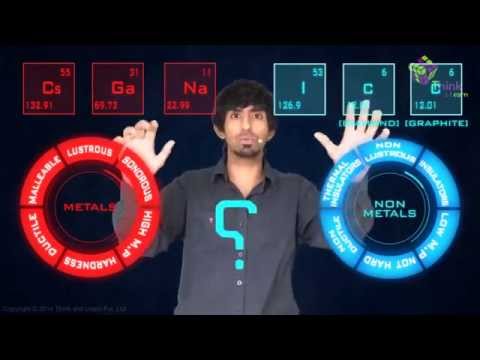As Is Metal Or Nonmetal
Metals and Nonmetals are different types of materials nowadays around us. Elements tin be divided into metals and nonmetals and it is important to know whether a particular element is a metal or nonmetal. Metals (like copper and aluminium) are good conductors of rut and electricity, while nonmetals (such as phosphorus and sulfur) are insulators. Materials are distinguished every bit above, based on their backdrop.
Tabular array of Content
- What are metals?
- Recommended Video on Metal and not-metallic
- What are Non metals?
- Properties of Metals
- Properties of Not-Metals
- Differences Between Metals And Non-metals
- Often Asked Questions -FAQs
The Majority elements in the periodic tabular array are metals. This includes alkali metals, transition metals, lanthanides, actinides and alkaline earth metals. Metals are separated past nonmetals on a periodic table through a zigzag line starting from carbon, till radon. The elements betwixt the two are phosphorus, selenium and iodine.
These elements and elements right to them in the periodic table are nonmetals. Elements nowadays just to the left of the line are termed equally semimetals or metalloids. These will have the combined properties of both metals and nonmetals.

Not-metals occupy the upper right-manus portion of the periodic table . Considering the properties of non-metals it is not shiny, malleable or ductile nor are they skilful conductors of electricity. These properties of non-metals provide 1 ways past which we can distinguish metals from not-metals.
Properties of Non-metals have less in common with each other than metals. Their physical and chemical properties vary widely. Some non-metals are solids and some are gases at room temperature.
Very few elements in the periodic table are not-metals. These are present on the right-mitt side in the periodic table. Elements that come under non-metals are sulphur, carbon, all halogens, phosphorus, hydrogen, oxygen, selenium, nitrogen and noble gases.
In the periodic table, non-metals are located left of the halogens and to the correct of the metalloids. Since noble gases and halogens are as well not-metals, these elements are often referred to as not-metals.
Physical Backdrop of Metals
Some concrete properties of metals are listed below.
- Shiny (lustrous) in nature
- Metal is a good conductor of electricity and heat
- Density and melting point is loftier
- Mouldable (Malleable)
- Ductile
- At room temperature, it is in solid form except for mercury
- Opaque
Chemic Properties of Metals
Some chemical properties of metals are listed beneath.
- Easily corrodible
- Tin can lose electrons
- Course basic oxides
- Take low electronegativities
- Good reducing agents
Concrete Properties of Non-metals
Some physical backdrop of non-metals are listed below.
- Poor conductors of electricity and rut
- Non-Ductile metals
- Brittle solids
- Peradventure solids, liquids or gases at room temperature
- These are not sonorous
- Transparent
Chemic Properties of Not-metals
Some chemical properties of non-metals are listed beneath.
- The number of electrons in the outer beat out is generally 4-viii
- Easily gain or lose valence electrons
- Form acidic oxides whenever they come in contact with oxygen
- High electronegative elements
- Great oxidizing agents
Non-metals and metals take different forms (allotropes). They accept dissimilar shapes and backdrop. Allotropes are elements that exist in 2 or more than than two different physical forms.
- Example i: A non-metal carbon – two allotropes of carbon are diamond and graphite.
- Example two: A metal such as iron – ii allotropes of fe are austenite and ferrite
Have a look at the given table depicting the major differences betwixt Metals And Non-metals for meliorate understanding.
A reactivity serial is a vital tool for chemists. It helps us to understand the properties of metals and the differences between them.
| Metals | Non-metals |
|---|---|
| These are solids at room temperature except mercury | These be in all three states |
| These are very hard except sodium | These are soft except diamond |
| These are malleable and ductile | These are breakable and can break down into pieces |
| These are shiny | These are non-lustrous except iodine |
| Electropositive in nature | Electronegative in nature |
| Have high densities | Take low densities |
Frequently Asked Questions – FAQs
What is called non-metal?
Not-metal is a element that does not have metal's properties. Some gases include hydrogen, helium, oxygen, nitrogen, fluorine, neon, radon and many more.
What is called Metal?
Many chemical elements are referred to every bit metals. These are the bulk of the periodic tabular array elements. More often than not, such components accept the following characteristics: these can conduct oestrus and electricity. They tin be hands shaped.
What are the uses of non-metal?
Oxygen is a non-metal that is used for animate by plants and animals. Information technology is essential to maintain our life. It is used in the process of fuel-burning in homes, factories, and vehicles for ship.
Which non-metal is essential for our life?
Oxygen is an essential non-metal for our life and it is inhaled during animate by all living beings.
Which non-metallic is used as a fuel?
The not-metal used in the rockets is liquid hydrogen. They are carve up hydrogen and oxygen tanks that combine and burn to showtime the rocket. Due to its high calorific value, hydrogen is used.
As Is Metal Or Nonmetal,
Source: https://byjus.com/chemistry/metals-and-nonmetals/
Posted by: alleynemage2002.blogspot.com


0 Response to "As Is Metal Or Nonmetal"
Post a Comment